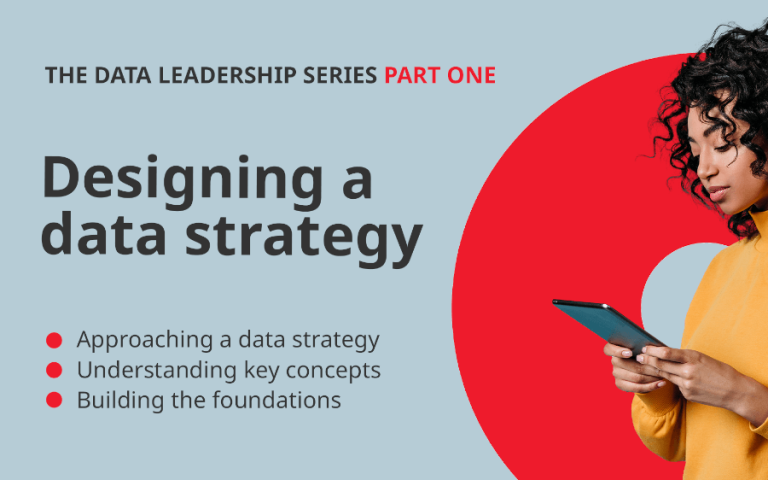Introduction
Does data deserve its own strategy, or should data be a bright and visible component of an organisation’s overall strategy? This question presents a false dichotomy. A data strategy should naturally be aligned with the organisation’s strategic objectives, but it deserves its own place in the Boardroom, the same way a marketing or financial strategy would be treated.
It is perhaps conceivable that you already have a data strategy, but perhaps it’s sitting in your top drawer and hasn’t been taken out for a while. This article is going to prompt some questions, but most importantly, it should prompt you to spin up any data strategy document that you have and ask, “Are the assumptions upon which this document was based still relevant?”
What is a data strategy?
A data strategy is a plan. It is a living document that provides the foundations for why an organisation is investing in data, how it will achieve its objectives, and what should be done.
If not treated as a living document, the assumptions will go out of fashion rather quickly. Time is the great equaliser of relevance, no matter how well the strategy document reads!
Focus on the outcomes
A data strategy has no value without measurable execution; the goal of a data strategy is not to have written a document but to deliver visible and meaningful progress against objectives.
Can measurable progress be claimed for the initiatives set in motion by your predecessors? If not, can you buy time to revise the data strategy and pivot to a better position?
Strong opinions, loosely held
The nature of a data strategy is that the principles shouldn’t change, but the prioritisation of resources and objectives should change based on new information. If the strategy is old, don’t be afraid to say that you need time to go deep with the principles and objectively assess the landscape to see what has shifted and what is still relevant.
Know when to change tack
Ultimately, a data strategy should serve the pursuit and realisation of an organisation’s objectives. If the core objectives are to make money, reduce costs and not kill the planet, and those aren’t being met, then the strategy – the plan – needs to change. It’s intelligent to change your course when presented with new information, but if you have no way of knowing where you are relative to the objectives initially set, you need to go back to basics.
Part 1: Approaching A Strategy
Start with the “Why”
As Simon Sinek rightly pointed out, Martin Luther King did not start his famous speech with “I have a plan.” Knowing your North Star and being able to explain the purpose of your data strategy will guide others.
Assess Your Capabilities
Making a realistic assessment of what your organisation’s capabilities are, and more importantly, what they are not, is a great starting point. Know your gaps. Fill them.
Reference Best Practice
Having a framework that is recognised as a definitive source of information based on the experience of others, is a shortcut to success. Avoid costly mistakes by using a reference point like DCAM™ or CDMC®.
Develop a Consensus
To go fast, go alone. To go far, go together. As a data strategy leader, you will need to bring others along on the journey, and at times there will be intransigence and doubt. Your mandate is legitimised by wide consensus.
Principles for Leadership
Be clear on your principles for leading a strategy and being accountable for its execution. How will you handle risk and conflict? How will your teams handle change and new ways of working? Reflect on this.
Part 2: Understanding Key Concepts
The Role of Data Management
If governance is the policy, then management is the execution. The solution needs systems and processes to solve any problem at scale; to manage data effectively, learn how it should be managed.
The Data Accountability Matrix
Bureaucracy is not just a failure of process but also a deep lack of ownership and empowerment. Use a matrix to show who is responsible for what in your data strategy to prevent the diffusion of responsibility.
Business & Technical Alignment
The business goals should be clear, and a data strategy should strongly align the technical resourcing and implementation of data value use cases to achieve goals that support your broader business objectives.
Foundations for Metadata
Metadata is essentially the data about other data, and the management of metadata helps to provide context for what is stored, processed or accessed at a system level. Think of a catalogue for all your data.
Skills & Capabilities Model
Do you specifically write data skills and capabilities into your job descriptions? Do you have a framework for assessing data skills you can apply to your business? If not, you need a new model.
Part 3: (Re)building The Foundations
How To Gather Requirements Effectively
To chop down a tree, sharpen your axe. It’s necessary to go around various teams and divisions to get a deeper and broader sense of how data is used across the organisation. Go for a walk and bring a notepad.
Creating Impactful Business Cases
When business cases are tied carefully to a business need and have a financial justification, you’re more likely to win the investment necessary to do the project. To get funded, write about the impact, not tech.
Prioritisation of Limited Resources
There is a finite budget and number of people with data expertise in any organisation. Say no to the good so you can say yes to the best – prioritise your investments with transparency and fairness.
Current/Future State Analysis
You need to know where you are and where you’re going to be able to demonstrate progress between organisational states. Having a clear idea of the outcome of a data strategy will help you measure your success.
Roadmaps and KPIs for Success
To go from A to B, it really helps to have an implementation roadmap tied to your data strategy that shows the timeframes, key deliverables and milestones at a high level to manage a lot of complexity.
Next steps
It is important to balance delivering impactful business cases/outcomes and delivering sustainable data capability. Going too far on one or the other will waste a lot of time and money.
Knowing your target and current states are vital. People often do not know exactly where they are starting from and struggle to reach their target.
Gone are the days when throwing people at the problem will solve it. There is a vital need to automate data management and have it embedded within automated business process execution to ensure the ‘jobs to be done’ get done!
Watch our online event recording, Designing A Data Strategy (June 2023), to learn more about this topic or get in touch with us to find out how we can help you develop a winning data strategy for your organisation.
contentS
- Introduction
- Part 1: Approaching a strategy
- Part 2: Understanding key concepts
- Part 3: (Re)building the foundations
- Next steps
Webinar
We discussed this topic – and much more! – with our amazing guest speakers in the 1st online event of our Data Leadership Series. Catch up now!



